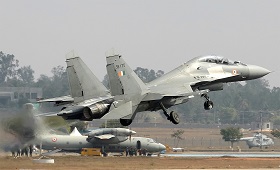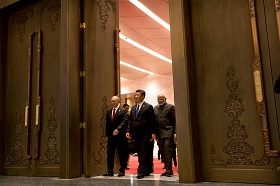The bilateral strategic partnership developed through economic integration, investment in people-to-people contacts, and driven by mutual interest, lasts longer than the one based on self-interest and transactional in nature. The Indo-Russian strategic partnership, based on old ties, has been relatively stable with defense trade and political support serving as its hallmark.
Although the Indo-Russian relationship has remained strategic and devoid of any conflict of interest in their strategic goals, the diasporic and trade relationship has been negligible when compared with that at the governmental level.
The Indo-Russian collaboration has been vibrant and active across multiple international forums including BRICS and Shanghai Cooperation Organization (SCO) that stand out amid the majority of international diplomatic forums led by the West. India’s accession to the SCO and the recent multinational counter-terrorism military exercise provides an opportunity to deepen its involvement in the Eurasian geopolitics.
At the St. Petersburg International Economic Forum (SPIEF) in 2015, the EAEU authorities along with their Indian counterparts decided to launch JFSG on FTA agreement between the Eurasian Economic Union and India.
In the South Asian region, both Russia and India have more space to collaborate, assist and strengthen Afghanistan government to lead the peace effort under the “Afghan-led and Afghan-owned” process.
The mantra for enhancing the Indo-Russian bilateral relationship should be: “Diversify and Deepen Trade, Think Opportunity, Look beyond Defense Deals.”
The bilateral strategic partnership developed through economic integration, investment in people-to-people contacts, and driven by mutual interest, lasts longer than the one based on self-interest and transactional in nature. It should have multiple lines of contact, each providing the space to maneuver through the complex maze of geopolitics. The Indo-Russian strategic partnership, based on old ties, has been relatively stable with defense trade and political support serving as its hallmark. However, as Eastern Asian geopolitical center of gravity shifts between different poles of influence, it is imperative to recalibrate the bilateral relationship and strengthen its foundations before building any strategic geopolitical expectations. The foundations can be bolstered by improving economic partnership and people-to-people contacts, and creating and sustaining cooperation through numerous diplomatic platforms (including non-governmental institutions of mutual interest).
Improving economic partnership and people-to-people accessibility
Economic ties between the states tend to be mostly driven by businesses, people (including diaspora) and by making the access to markets and society easier and more efficient. In the distant corner of Eastern India, far from Delhi’s diplomatic corridors, it’s the ordinary Russian tourist in a temple city of coastal Odisha, or an Indian café managed by an Indian entrepreneur in the far eastern city of Vladivostok, that drives the relationship and represents their nation more than any diplomat or special envoy. Similarly, in the racks of a local supermarket, the Made in India/Russia products would represent the depth of trade and commerce in real terms. They also play a direct role in influencing the public view of a country. Although the Indo-Russian relationship has remained strategic and devoid of any conflict of interest in their strategic goals, the diasporic and trade relationship has been negligible when compared with that at the governmental level.
On the other hand, the Indo-U. S partnership, though with differences in their strategic interests, is supported by 3.9 million Indian diasporas and USD 126.7 billion of bilateral trade over the years and continues to grow. Today, Indian businesses are more dependent on the U.S and Europe as preferred markets than Russia. A survey report on the prospects of Free Trade Agreement (FTA) between India and Eurasian Economic Union (EAEU) prepared by Federation of Indian Chambers of Commerce (FICCI), has highlighted the series of challenges faced by the Indian businesses in the EAEU region. Over 80% of the total respondents have their businesses in Russia and expect better market access, visa regime and investment security as necessary conditions for improving trade between two nations. The Joint Feasibility Study Group (JFSG) instituted by India and EAEU authorities painted a similar picture. Both reports emphasized the success of the International North-South Trade Corridor (INSTC) and the creation of “Green Corridor” between India and Russia to achieve the USD 30 billion trade goal by 2025. Both countries must explore the opportunities to collaborate and lead joint ventures in the Indo-Pacific wherever feasible. The collaboration has to include areas other than defense trade to diversify and deepen the spectrum of trade relations. The successful acquisition of 49% stake in Essar Oil limited by Rosneft, investment from Israeli-Russian investor Yuri Milner in Indian startup space and Sistema Shyam Teleservices-RCom collaboration, are some bright spots to be looked upon.
In case of diasporic relationship between Russia and India, the numbers aren’t encouraging either. The total number of Indians (including students and permanent residents) residing in Russia is under 15,000, and so far, a minuscule of Indian diaspora is part of Russian politics. To put it squarely, the thrust that diaspora generally gives to a bilateral relationship is lacking here. Hence, in the absence of diasporic factor, other channels such as tourism through Visa-on-Arrival (VoA) must be encouraged. Some steps, such as the extension of VoA scheme to Indians to selected cities in Russia’s Far Eastern Federal District are encouraging, though not sufficient at all.
Creating and sustaining cooperation across diplomatic platforms
The Indo-Russian collaboration has been vibrant and active across multiple international forums including BRICS and Shanghai Cooperation Organization (SCO) that stand out amid the majority of international diplomatic forums led by the West. India’s accession to the SCO and the recent multinational counter-terrorism military exercise provides an opportunity to deepen its involvement in the Eurasian geopolitics. Also, the bilateral collaboration has been strategic in terms of creating new financial institutions that would shape the global economic order in the long term. The New Development Bank (NDC) as a multinational financial lending institution provided two countries, an opportunity to actively steer the development across the globe by financing viable projects. The bank has so far approved 21 projects of over USD 5 billion since its creation in 2014.
On the other hand, it was at the St. Petersburg International Economic Forum (SPIEF) in 2015, when the EAEU authorities along with their Indian counterparts decided to launch JFSG on FTA agreement between the Eurasian Economic Union and India. SPIEF has since welcomed Indian participation. These arrangements add to the existing Inter-Governmental Commissions (IGCs) and Joint Working Groups (JWGs) as a model of bilateral engagement. There are also efforts from either side to create business opportunities and improve economic ties by inter-linking India and Russia through Russia’s Far East. In this regard, India has been participating in Eastern Economic Forum (EEF) for some years. In a recent EEF meeting, Indian commerce minister reiterated country’s support for the active participation of Indian companies in the development of Russia’s Far East region. It has to be remembered that Russia through its Far East region, is an active stakeholder in the Indo-Pacific geostrategic region. It also makes India a stakeholder in Northeast Asian geopolitics. And as it upgrades its relationship with North Korea, it can play a constructive role in bringing peace to the Korean peninsula, while giving diplomatic space to the hermit kingdom. In the South Asian region, both Russia and India have more space to collaborate, assist and strengthen Afghanistan government to lead the peace effort under the “Afghan-led and Afghan-owned” process.
The Road Ahead
In the last few years, numerous analyses have been published across major think tanks highlighting the decline in India–Russia relationship, as the former engages with the U.S to offset the Chinese military aggressiveness along its borders and in the Indian ocean. Most of these analyses are purely based on geopolitical considerations by only taking military and diplomatic maneuvers into account. However, they ignore the fact that, while geopolitical tensions will continue to exist, bilateral partnerships aren’t bland and narrow, rather they have many areas to evolve. In the absence of a strong economic partnership, people–to-people contact and international collaboration, the relations will remain hostage to the whims of the political leaders at the helm of affairs in their respective country. Therefore, the mantra for enhancing the Indo-Russian bilateral relationship should be: “Diversify and Deepen Trade, Think Opportunity, Look beyond Defense Deals.”







